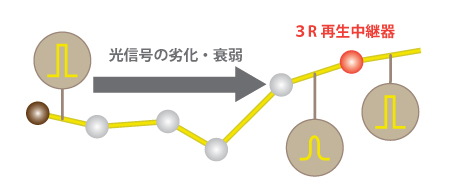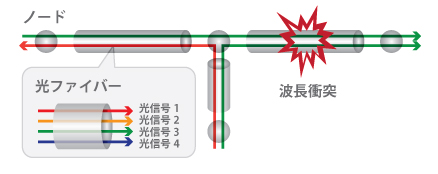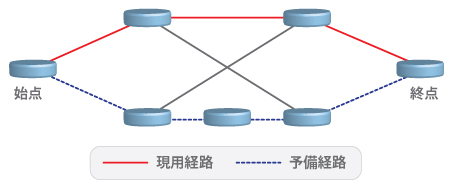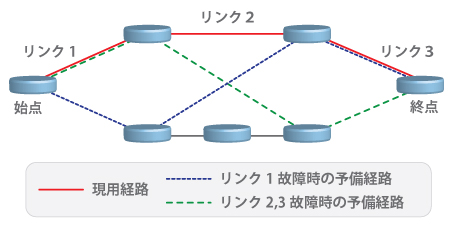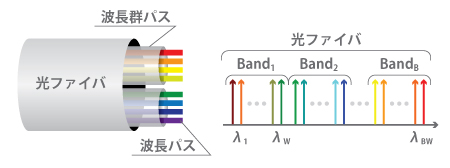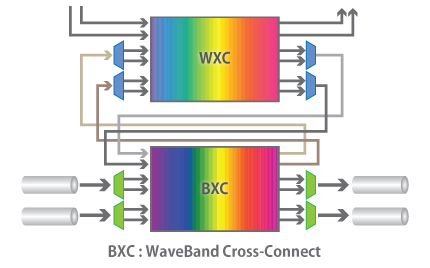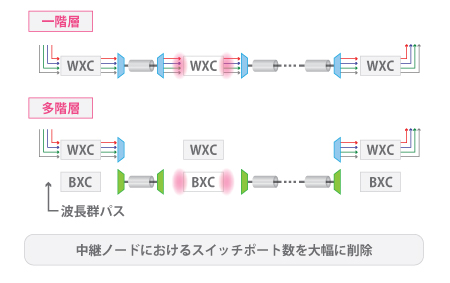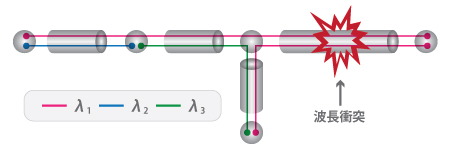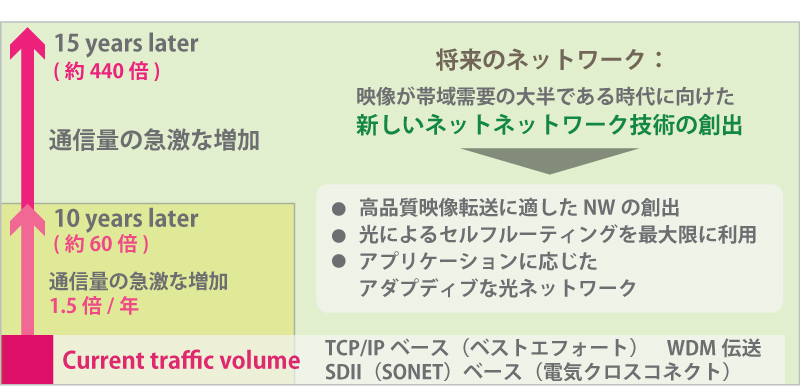Research Overview
(1) Communication Network Architecture and Design

Research Topics
Communication Network Architecture and Design
Large-Scale Network Design
Recently, photonic networks that aim at realizing both ultra-high speed and low power consumption, have been introduced in the metro/backbone networks of domestic and foreign service providers, where the electrical processing is cut-through with optical layers. Currently, each photonic network hosts several tens of nodes, however, the number of optical nodes that are optically transparently connected is expected to increase in the future due to the traffic growth and advances in optical technologies that enable expansion of transparent reach and the development of efficient large scale OXCs/ROADMs.
The major issues restricting the expansion of the transparent network scale are;
Limited transmission distance without regenerators Optical signals are degraded when they pass through optical fibers and optical nodes. Thus, signal regenerators should be inserted at fixed distances in long haul networks, where the optical waveform is amplified and reshaped. Since, this processing incurs high cost and high power consumption, the number of regenerators should be as small as possible (see Fig. 1).
(ii) Sharp increase in the cost of network maintenance and managementSignals of the same wavelength cannot the same optical fiber, and hence, proper wavelength assignment and path routing are necessary (see Fig. 2). The optimal assignment is to be known to be an NP complete problem. Hence, obtaining the exact solution is almost impossible, especially for large-scale networks.
In this research area, we are overcoming these problems to allow the deployment of photonic networks.
Reliable Network Design against Network Failures
Due to construction or human errors, fiber cuts are all too frequent in commercial telecommunication networks. Since a lot of important information is exchanged in the current network environment, network robustness against failures is absolutely imperative, and prompt failure recovery is essential. To this end, both static and dynamic failure recovery design methods have been proposed. In a static failure recovery design method, a protection route is prepared beforehand for each working route so that recovery is realized by switching to the protection route when a failure has occurred, while in a dynamic failure recovery method, the restoration route is dynamically calculated upon the detection of the failure.
By using these methods, a high degree of reliability can be achieved, however, additional cost is required due to the preparation of protection/restoration resources such as optical fibers and network equipment (NE). Since the cost of fibers and NE’s is generally high enough, it is important to minimize the amount of protection/restoration resources needed.
In this research area, we have developed a network design methodology that offers a high degree of optical network reliability while minimizing the additional cost.
Adaptable Photonic Routing Network Architecture and Design with Bit-Rate and Distance
The penetration of streaming services such as YouTube or USTREAM, etc., has triggered a rapid increase in communication demand. Furthermore, in order to accommodate super-high resolution image applications, it is necessary to utilize the limited frequency bandwidth of optical fibers in a more efficient way.
Conventional optical networks use the ITU-T grid, which was standardized by the international standard body, ITU-T; where a fixed frequency spacing is allocated between neighboring grids. Recently, new technologies have been introduced such as Spectrum-sliced elastic optical path network (SLICE), Bit-rate Adaptive (BA) modulation, and Distance Adaptive Modulation (DA). Through these new technologies, bandwidth can be flexibly allocated to each communication demand so as to achieve efficient optical communications.
For instance, since noise increases in proportion to the communication distance, a narrow bandwidth is allocated to short-distance communication demands, while a wide bandwidth is allocated to long-distance communication demands, as shown in the following figure.
The objective of this research topic is to minimize the allocated bandwidth to achieve more efficient networks.
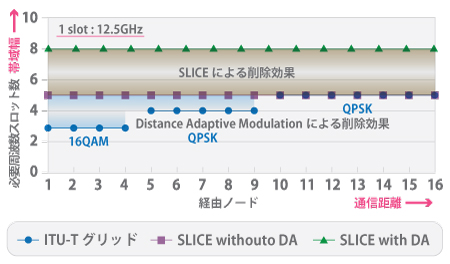
Figure5 Effect of bandwidth allocation in the case of SLICE and DA
Hierarchical Optical Path Network Design
In addition to the data communication established by HTTP and FTP, new applications such as super-high resolution images will be expected to emerge in the future. This will lead to an explosion in the amount of traffic.
Research on “Optical Network Technology” is currently underway, where a different label is assigned to each of the optical signals multiplexed in the same optical fiber. Label switched routing is applied to each of the optical signals. As a result of this research, single layer optical path networks have been put to practical use in Japanese and foreign telecommunication networks. In the single-layer optical path network, the transfer unit called “wavelength path” is introduced. In order to cope with the increase in the amount of traffic in the future, even higher capacity and efficiency are inevitable. A remaining problem is to cost effectively implement a large-scale optical switch element that realizes wavelength path level processing.
In order to overcome the limitation of the single-tier optical path network, the “multi-level optical path network” has been attracting a lot of attention; it introduces the “waveband path” to aggregate multiple wavelength paths in a logical manner. By using this technology, the size of an optical switch can be reduced since multiple wavelength paths can be switched and transferred as one unit.
In order to minimize switch size, we need to study not only multi-granular optical switch architectures (reference: the study on the ultra-high capacity photonic routing systems/nodes), but also “Optical Network Design,” which offers whole optical network optimization. Through whole optical network optimization, the cost of switches and fibers can be minimized by allocating the appropriate route and wavelength to each of the optical paths under the condition that the necessary number of optical paths is assigned to each link between arbitrary node pairs. However, the assignment is inherent difficult to solve even if we consider a conventional single-tier optical path network, since it is an NP complete problem. For multi-granular optical path networks, it is much more difficult to determine the optimal path assignment since wavelength paths and path groups form a nested structure.
Our approach to this research area is to pursue sub-optimum solutions aiming at the practical realization of efficient hierarchical optical networks by using heuristic methods.
High-Speed Optical Cross-Connect Network Architecture
Against the background of the rapid increase in communication traffic, the fact that the Internet continues to penetrate throughout the world, is reinforced by the migration from data services such as voice and file transfer to moving image services with their extremely large traffic flows. This is due to the introduction and rapid penetration of streaming type applications such as YouTube or USTREAM. In the future, it is expected that super high-resolution images such as Ultra-HDTV (72Gbps/channel) will emerge and enter into wide-spread use.
In order to provide such high-capacity services in an efficient way, optical communication with both low power consumption and ultra-high speed transmission capabilities, is essential, in addition to the conventional electrical packet communication. Hence, we believe that the future network will adopt the overlay architecture that includes both Internet type data networks and optical circuit switched networks for large capacity video (i.e. 72 Gbps/channel) content delivery, and that the most suitable network is selected according to the type of services desired.
In order to break the limitation of the single-layer optical path network, the “multi layer optical path network” is now being intensively investigated, where a “waveband path” is introduced; it accommodates multiple wavelength paths in a logical manner. By using this technology, the size of the optical switch can be reduced since multiple wavelength paths can be collectively switched and transferred as a unit.
Optical Flow Switching Network Architecture
Design Optimization of Optical/Electrical Hierarchical Network
In response to the sharp increase in the number of Internet users, broadband access such as ADSL or FTTH has been rapidly adopted, which has brought an increase in the amount of both network traffic and power consumption. Current Internet backbone IP networks widely use WDM (Wavelength Division Multiplexing) technology. The current WDM network is usually a point-to-point system, where all wavelengths are terminated at each optical node. In this system configuration, optical-electrical-optical (O-E-O) conversion is necessary at each repeater node, which inevitably leads to high O-E-O conversion cost. In order to resolve this cost problem, research and development of photonic networks us underway to introduce wavelength routing technologies, where the optical signals are directly routed without any O-E-O conversion.
The wide penetration of optical node technologies should be considered given that the communication traffic keeps increasing rapidly. Our solution is to propose a hybrid hierarchical network architecture, where the OXC (Optical Cross-Connect) network with wavelength routing capabilities is added to the existing electrical forwarding network. An efficient hierarchical network design for large-scale networks has been also proposed. These research advances will reduce network cost and the time taken to compute the network design.
Ultra-Low Power Consumption Network
As a result of the rapid penetration of broadband access such as ADSL or FTTH, the amount of traffic is increasing rapidly. This trend is expected to last for a long time due to the emergence and introduction of super high-resolution image applications such as Ultra-HDTV (72Gbps/channel) and so on. In response to the increase in the amount of traffic, the power consumed by telecommunication equipment is rapidly increasing. As of 2007, the amount of power consumed worldwide by all communication equipment was reported to exceed 8 Billion kWh. It is inevitable that the power consumption of networks must be reduced.
In current optical networks, route processing at each router is made at the electrical level through optical-to-electrical conversion, which consumes a significant amount of electrical power, and the output electrical signal is converted into an optical signal through electrical-to-optical conversion. O-E-O conversion is not only costly, but also a dominant factor increasing the power consumption of communication equipment. Thus, in order to attain low power consumption, we are actively pursuing the practical use of photonic networks, where the wavelength routing technologies are applied to cut-through electrical routing processing on optical paths without recourse to O-E-O conversion.
In our laboratory, various kinds of research are being performed towards attaining ultra-low power consumption photonic networks.
